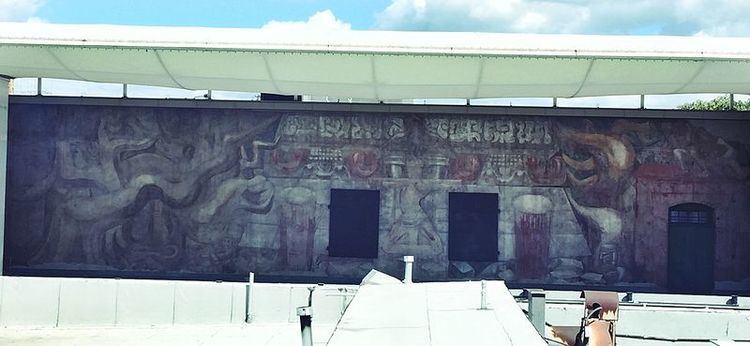Year 1932 Dimensions 18 ft x 82 ft Created 1932 | Type Mural Condition Restored in 2012 | |
 | ||
Similar David Alfaro Siqueiros artwork, Mural, Other artwork | ||
América Tropical is a 1932 mural created by David Alfaro Siqueiros in Los Angeles, California
Contents
It was painted over soon after its completion on an external wall of the Italian Hall on Olvera Street in El Pueblo de Los Angeles Historical Monument of Downtown Los Angeles. It was restored and revealed to the public in 2012, 80 years to the day after its first unveiling.
History
Siqueiros came to Los Angeles as a political refugee in 1932 and was sponsored by the Plaza Art Center to create a mural that was supposed to be about happy men, parrots, palms with falling fruit into the mouths of people. However, Sequeiros completely disobeyed the institutional project request in exchange of his own unique artistic idea by creating his own mural, which turned out to be one of the most controversial art pieces in Los Angeles history, Tropical America (full name: América Tropical: Oprimida y Destrozada por los Imperialismos, or Tropical America: Oppressed and Destroyed by Imperialism).
The mural became the center of controversy, as the painting clearly depicted a Maya like pyramid with surrounding twisted trees and in the center was an indigenous person crucified, dead on a double edged cross. There is sculptures laying at the bottom of the mural destroyed, which signify pre-Columbian architecture and ancient indigenous civilization. On the left side of the pyramid there are two snipers overlooking the imperial American eagle whom is on top of the crucified indigenous person and the two Mexican revolutionary snipers look ready to shoot at any time.
Although, the mural is almost non-existent today because of the damage that it has sustained from being unprotected from sunlight, rain and even layers of paint that were thrown over it 70 years ago because of the requests of Angelino Anglo elites. América Tropical is an emblematic part of the Mexican muralism movement that happened from 1920s-1970s and later inspired the Chicano art movement in the United States for Mexican-Americans. Siqueiros also belonged to one of the most elite groups of artists from the Mexican Revolution known as "the big three", Diego Rivera and José Clemente Orozco. The three of them went around all over Mexico, Latin America and the United States painting murals that depicted the struggles of people.
Restoration
América Tropical is not only a mural but it is an intricate part of Los Angeles history. As restoration for Siqueiros' mural continues today, the Getty Foundation, via the Getty Conservation Institute, has spent 3.95 million dollars in restoration project, while the city of Los Angeles has also contributed 5 million dollars for the conservation of the mural. The project scope is to conserve, interpret, and provide public access to the mural.
Work has been completed on: documentation, cleaning, reattachment, stabilization, and treatment of the mural; constructing a shelter and viewing platform on an adjacent roof with elevator access; and the América Tropical Interpretive Center.
